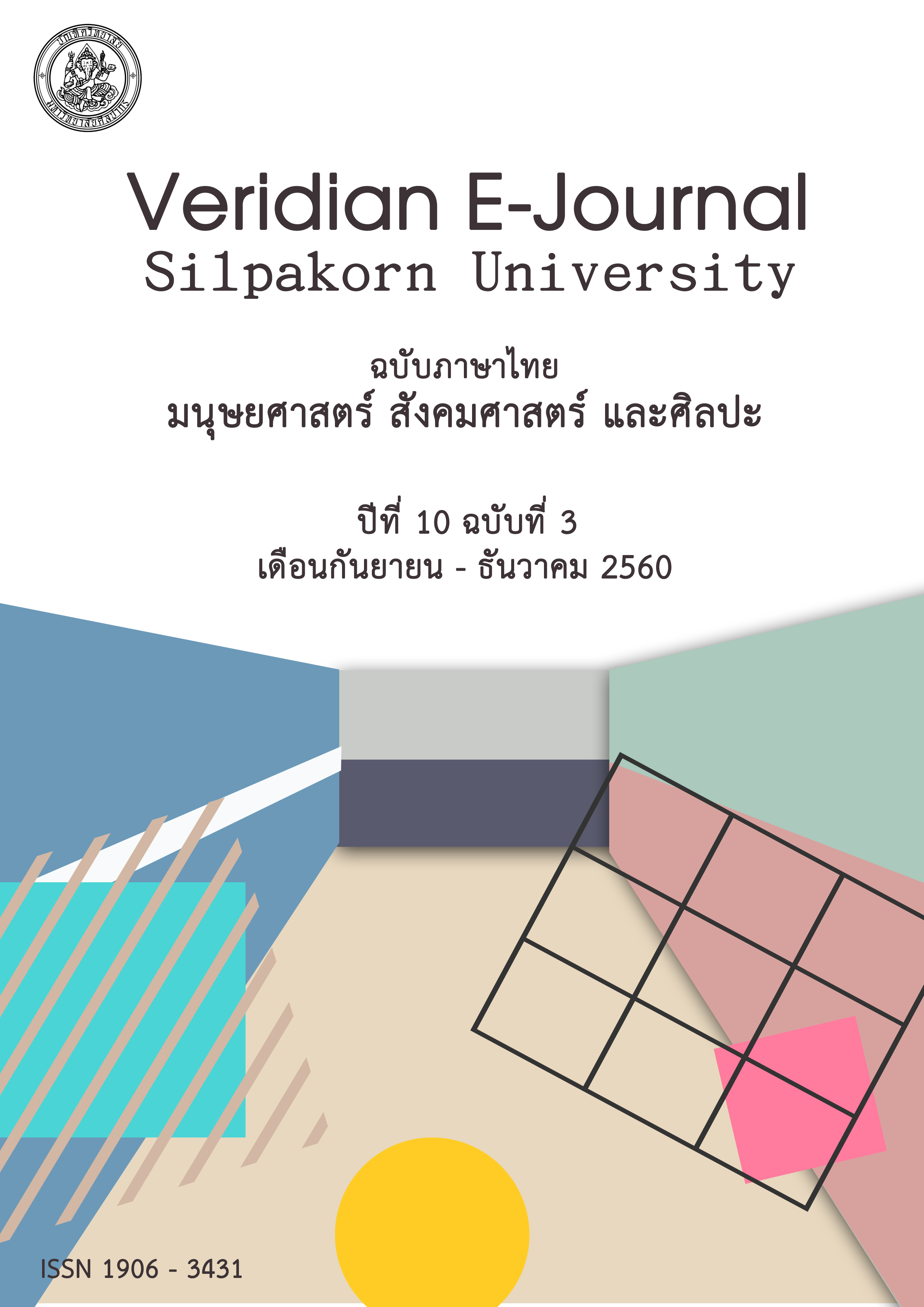การประเมินหลักสูตรศิลปมหาบัณฑิต สาขาวิชาทัศนศิลปศึกษา คณะจิตรกรรมประติมากรรมและภาพพิมพ์ และคณะศึกษาศาสตร์ มหาวิทยาลัยศิลปากร
Main Article Content
Abstract
การวิจัยเรื่อง การประเมินหลักสูตรศิลปมหาบัณฑิต สาขาวิชาทัศนศิลปศึกษา คณะจิตรกรรมประติมากรรมและภาพพิมพ์ และคณะศึกษาศาสตร์ มหาวิทยาลัยศิลปากร มีวัตถุประสงค์ 1) เพื่อประเมินหลักสูตรหลักสูตรศิลปมหาบัณฑิต สาขาวิชาทัศนศิลปศึกษา คณะจิตรกรรมประติมากรรมและภาพพิมพ์ และคณะศึกษาศาสตร์ มหาวิทยาลัยศิลปากร ในด้านบริบท ด้านปัจจัยนำเข้า ด้านกระบวนการ ด้านผลผลิต ด้านผลกระทบ ด้านประสิทธิผล ด้านความยั่งยืน และด้านการถ่ายโยงความรู้ 2) เพื่อศึกษาปัญหาและแนวทางการพัฒนา ปรับปรุงหลักสูตรศิลปมหาบัณฑิต สาขาวิชาทัศนศิลปศึกษา คณะจิตรกรรมประติมากรรมและภาพพิมพ์ และคณะศึกษาศาสตร์ มหาวิทยาลัยศิลปากร
คณะผู้วิจัยใช้วิธีการประเมินของ Danial L. Stufflebeam รูปแบบการประเมินแบบ CIPPIEST Model โดยประเมินผลหลักสูตรใน 8 ด้านคือ ในด้านบริบท ด้านปัจจัยนำเข้า ด้านกระบวนการ ด้านผลผลิต ด้านผลกระทบ ด้านประสิทธิผล ด้านความยั่งยืน และด้านการถ่ายโยงความรู้ เก็บรวบรวมข้อมูลโดยการสอบถามความคิดเห็นผู้ที่เกี่ยวข้องกับการใช้หลักสูตร 5 กลุ่ม ได้แก่ บัณฑิต จำนวน 29 คน นักศึกษา จำนวน 23 คน คณาจารย์ผู้สอน จำนวน 17 คน คณะกรรมการบริหารและอาจารย์ประจำหลักสูตร จำนวน 14 คน และผู้ใช้บัณฑิต จำนวน 17 คน เครื่องมือที่ใช้ในการวิจัย ประกอบด้วย แบบสอบถามปลายปิดแบบมาตราส่วนประมาณค่าและแบบสอบถามปลายเปิด การวิเคราะห์ข้อมูลใช้ค่าสถิติคือ ค่าความถี่ (Frequency) ค่าร้อยละ (%) ค่าเฉลี่ย () ค่าเบี่ยงเบนมาตรฐาน (S.D.) และการวิเคราะห์เนื้อหา (Content Analysis)
ผลการประเมินหลักสูตร พบว่า
1) ผลการประเมินรวมอยู่ในระดับเหมาะสมมากที่สุด ( = 4.52, SD. = 0.52) และเมื่อพิจารณาเป็นรายด้าน คือ ด้านบริบท ด้านปัจจัยนำเข้า ด้านกระบวนการ ด้านผลผลิต ด้านผลกระทบ ด้านประสิทธิผล ด้านความยั่งยืน และด้านการถ่ายโยงความรู้ อยู่ในระดับมากที่สุดทุกๆ ด้าน
2) ปัญหาและแนวทางการพัฒนา ปรับปรุงหลักสูตรฯ ดังนี้
2.1 ด้านบริบท พบว่า วัตถุประสงค์บางข้อ มีความซ้ำซ้อนกัน จึงควรปรับวัตถุประสงค์ของหลักสูตรให้กระชับขึ้น ไม่ซ้ำซ้อน ในด้านโครงสร้างของหลักสูตร ควรปรับรายวิชาที่มีลักษณะซ้ำซ้อนกัน บูรณาการเนื้อหาวิชาเป็นรายวิชาเดียวกัน ทำให้รายวิชากระชับขึ้น
2.2 ด้านปัจจัยนำเข้า พบว่า นักศึกษาที่เข้าเรียนในหลักสูตร มีพื้นฐานที่แตกต่างกันมาก จึงควรจัดกลุ่มระดับพื้นฐานความรู้ความสามารถ หรือมีการจัดกิจกรรมเสริมเพื่อปรับพื้นฐานก่อนเปิดภาคการศึกษา
2.3 ด้านกระบวนการ พบว่า การจัดการเรียนการสอนในหลักสูตร ไม่มีการนำนักศึกษาออกไปทัศนศึกษาภายนอกห้องเรียน จึงควรจัดให้มีการพานักศึกษาไปศึกษาดูงานนอกสถานที่
2.4 ด้านผลผลิต พบว่า จำนวนนักศึกษาที่เลือกทำวิทยานิพนธ์ทางด้านวิจัยทางศิลปศึกษามีจำนวนน้อยกว่านักศึกษาที่ทำวิทยานิพนธ์ด้านสร้างสรรค์ จึงควรเพิ่มการฝึกปฏิบัติการทำวิจัยทางด้านศึกษาศาสตร์ เพื่อฝึกฝนการทำวิจัยและเพิ่มความมั่นใจให้กับนักศึกษา กระตุ้นให้นักศึกษาเข้ารับฟังสัมมนาทางวิชาการต่างๆ เพิ่มขึ้น
2.5 ด้านผลกระทบ พบว่า ขาดการสนับสนุนด้านงบประมาณและเวทีนำเสนอผลงานวิชาการระดับนานาชาติ รวมทั้งหอศิลป์ให้นักศึกษาหรือบัณฑิตจัดแสดงผลงาน ทางหลักสูตรฯ ควรสนับสนุนงบประมาณและสถานที่ และ/หรือการหาข้อมูลประชาสัมพันธ์เพื่อให้นักศึกษาทราบ
The objectives of the research entitled "The Evaluation of Master's Degree Program in Visual Arts Education, Faculty of Painting, Sculpture and Graphic Arts and Faculty of Education, Silpakorn University" were to 1) evaluate the Master's Degree Program in Visual Arts Education, Faculty of Painting, Sculpture and Graphic Arts and Faculty of Education, Silpakorn University in context, input, process, product, impact, effectiveness, sustainable and transportability 2) study problems and guidelines to improve the Master's Degree Program in Visual Arts Education, Faculty of Painting, Sculpture and Graphic Arts and Faculty of Education, Silpakorn University.
The research team used Danial L. Stufflebeam evaluation model. The CIPPIEST model was used in eight contexts, namely: Context, Input, Process, Product, Impact, Effectiveness, Sustainable and Transportability. The data was collected by using questionnaires consisted of 5 groups of people involving in the curriculum: 29 graduates, 23 students, 17 faculty members, 14 committee/routine curriculum instructors, 17 graduate's employers. The research instruments used in the study were rating scale and open-ended questionnaires. The collected data were analyzed by using percentage (%), mean (), standard deviation (S.D.) and content analysis.
The results of the research revealed 1) the overall result was at the most appropriate level of evaluation ( = 4.52, SD. = 0.52). Considering each aspect; the Context, Input, Process, Product, Impact, Effectiveness, Sustainability, and Transportability evaluation, were all at the most appropriate level of evaluation.
2) Problems and the guidelines to improve the curriculum are as follows:
2.1. Contextual aspect found that some objectives of the program are redundant, so the program’s objectives should be tightened up, and not overlapping. In the program’s structure aspect, duplicate courses should be adjusted, and integrated of same subject matter into the same course to make the course more compact.
2.2 The Input aspect indicates that students enrolling in the course have very different basic knowledge. Therefore, they should be grouped by basic knowledge, and take additional activities to adjust the foundation before starting the semester.
2.3 The Process aspect found that the program has no field trips. Therefore, it should arrange a field trip for students.
2.4 The Product aspect found that the number of students who chose doing thesis in the field of research in art education was lower than that of doing thesis in creation of artwork. The program should increase the practice of research in art education to practice doing a research and increase student confidence, and encourage students to attend more academic seminars.
2.5 The Impact aspect found the lack of support budget and the international academic presentation stage including art galleries for students or graduates to exhibit their work. The program should support the budget and places, and provide information for students.
